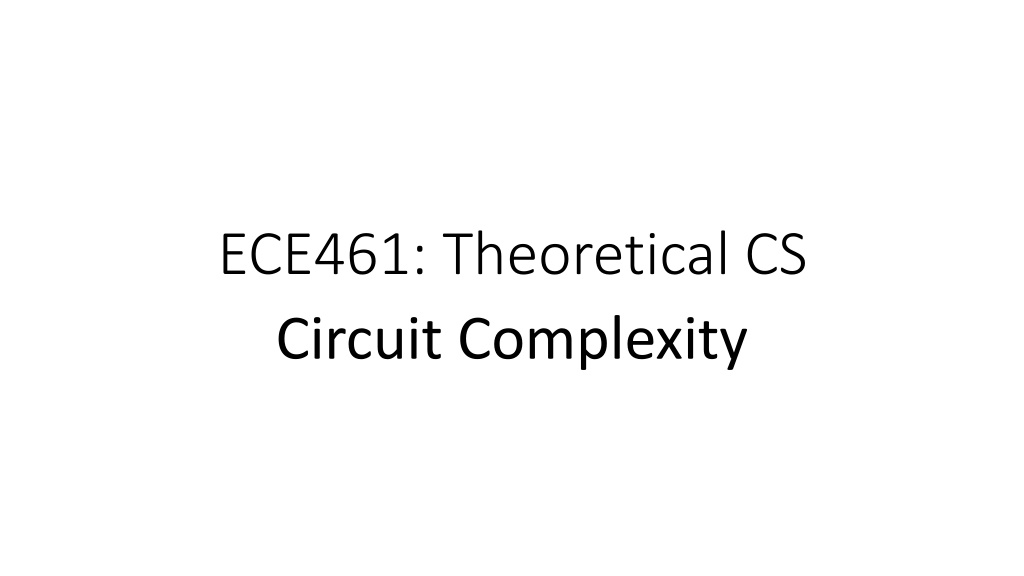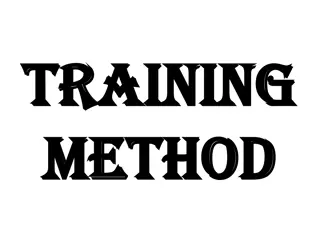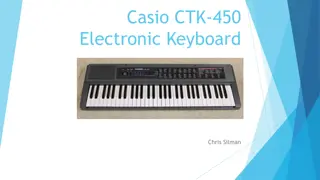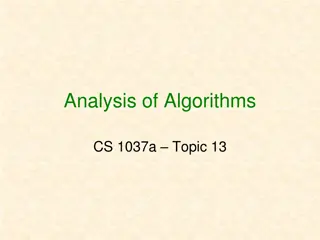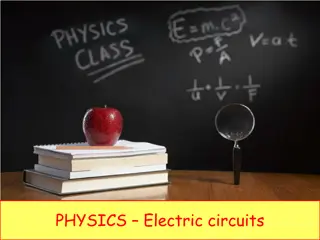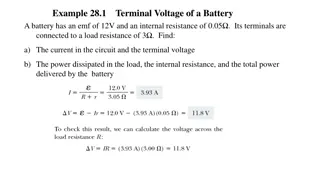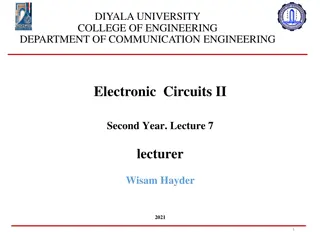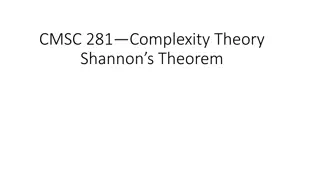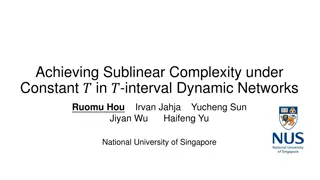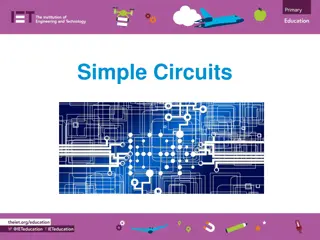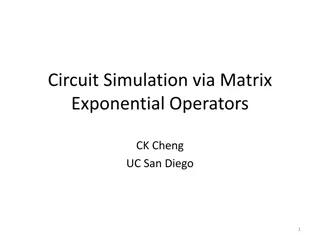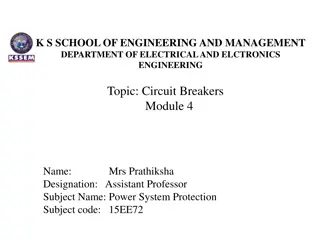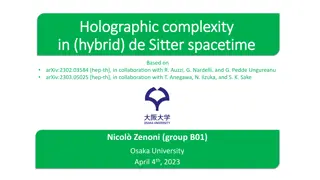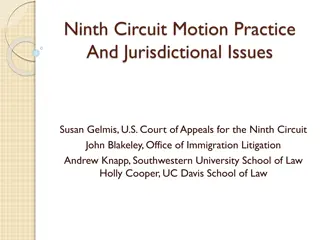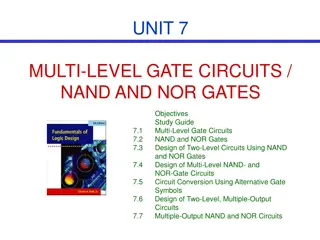Circuit Complexity
Section 9.3 of the textbook delves into circuit complexity, introducing Boolean circuits and circuit families. It explores the relationship between Turing machines and circuits, offering insights into P versus NP questions through the lens of computational models such as circuits. The Cook-Levin theorem and NP-completeness of 3SAT are discussed as well.
Uploaded on Feb 15, 2025 | 0 Views
Download Presentation

Please find below an Image/Link to download the presentation.
The content on the website is provided AS IS for your information and personal use only. It may not be sold, licensed, or shared on other websites without obtaining consent from the author.If you encounter any issues during the download, it is possible that the publisher has removed the file from their server.
You are allowed to download the files provided on this website for personal or commercial use, subject to the condition that they are used lawfully. All files are the property of their respective owners.
The content on the website is provided AS IS for your information and personal use only. It may not be sold, licensed, or shared on other websites without obtaining consent from the author.
E N D
Presentation Transcript
ECE461: Theoretical CS Circuit Complexity
Brief Recap Earlier in the course, we discussed topics related to computability theory, which relates to the question of which languages or decision problems are decidable Our primary models of computation have been deterministic Turing machines (DTMs) and nondeterministic Turing machines (NTMs) If we accept the Church-Turing thesis, all algorithms can be implemented by Turing machines We have learned that computation is inherently limited, and that some languages are undecidable; an important tool in proving this has been diagonalization Then we started to cover complexity theory, which explores which languages can be decided efficiently We introduces time and space complexity classes Two important time complexity classes are P P and NP NP, which are believed to be different, but the P P versus NP question has never been solved The existence of NP NP-complete languages give us some insight into the question; the definition of NP- completeness relies on the concept of polynomial time mapping reducibility In our previous topic, we were reintroduced to the concept of oracles; we learned that P and NP are the same relative to some oracles, but different relative to other oracles This conclusion has important implications related to the limits of diagonalization NP
Circuit Complexity Overview Section 9.3 of the textbook introduces a concept known as circuit complexity The book defines the notion of a Boolean circuit, and an extension called a circuit family We will see that any TM deciding a language can be converted to a circuit family Sipser states that "researchers believe that circuits provide a convenient computational model for attaching the P versus NP and related questions" This section also provides an alternative proof of the Cook-Levin theorem, and, in particular, that 3SAT is NP-complete We will not cover this topic in as much detail as the textbook
Boolean Circuits Definition 9.21 states (I am keeping the book's exact wording, but changing the formatting a bit): A Boolean circuit is a collection of gates and inputs connected by wires. Cycles aren t permitted. Gates take three forms: AND gates, OR gates, and NOT gates, as shown schematically in the following figure. The figure referred to in the definition is:
Boolean Circuit example Although not stated in the definition, the section assumes that each Boolean circuit has a designated output gate The book shows a few examples of Boolean circuits; we'll just look at one that determines computes the parity function of four inputs:
Circuit Families Each Boolean circuit requires a fixed number of inputs Languages, on the other hand, can contain strings of different lengths To rectify this disparity, we can define a circuit family Definition 9.27 states (I am keeping the wording exact, but changing the formatting): A circuit family C is an infinite list of circuits, (C0, C1, C2, . . .), where Cnhas n input variables. We say that C decides a language A over {0,1} if for every string w, w A iff Cn(w) = 1, where n is the length of w. The size of a circuit is the number of gates it contains A circuit is minimal if there is no equivalent circuit with a smaller size; a circuit family is minimal if all the circuits within it are minimal The size complexity of a circuit family is a function f: N N, were f(n) is the size of Cn The depth of a circuit is the longest path from an input to the output gate We can define depth minimal circuits and circuit families, and depth complexity, analogous to how we did for size
Circuit Complexity Definition 9.28 states (I am keeping the book's exact wording): The circuit complexity of a language is the size complexity of a minimal circuit family for that language. The circuit depth complexity of a language is defined similarly, using depth instead of size. Book: "The circuit complexity of a language is related to its time complexity" Theorem 9.30 states: "Let t: N N be a function, where t(n) n. If A TIME(t(n)), then A has circuit complexity O(t2(n))." We are not going to cover the proof in detail, but I'll discuss the high-level details concepts The book explains that for any time complexity t(n) algorithm implemented by TM, M, we can represent the computation of a M on its input w as a tableau; a depiction of such a tableau is shown on the next slide Unlike in the past, they combine the current state and symbol it's over as one symbol in each configuration Assumptions are made so that the bottom left cell of the tableau contains the Boolean output of the circuit The book shows that a Boolean circuit equivalent to M on this sized input can be generated with a large, but constant, number of gates in each cell of the tableau The symbol in each cell only depends on the three cells above it (directly above, above-left, and above-right) The book says that lights can be placed for each possible symbol in every possible cell Each light will turn on when that symbol is in the cell; the figure in two slides helps to explain this Ultimately, M accepts w if and only if the bottom left cell indicates the accept state
CIRCUIT-SAT A Boolean circuit is satisfiable iff there exists some input that causes the circuit to output 1 The circuit-satisfiability problem "tests whether a circuit is satisfiable" We can define the corresponding language as follows: CIRCUIT-SAT = { C | C is a satisfiable Boolean circuit} Theorem 9.33 states: "CIRCUIT-SAT is NP-complete" The proof is somewhat short, but were just going to discuss the high-level details Clearly, CIRCUIT-SAT is in NP To show that CIRCUIT-SAT is NP-hard, consider any NP language, A A must have a polynomial time verifier, V, whose input has the form <x, c>, where c is a certificate proving that x is in A According to Theorem 9.30, we can construct a Boolean circuit equivalent to V The part of the circuit that corresponds to x gets filed in with the symbols of w The circuit is satisfiable if and only if there is some certificate, c, proving that w is in A The book then demonstrates a polynomial time reduction from CIRCUIT-SAT to 3SAT, leading to another proof that 3SAT is NP-complete; we won't cover the details
Thoughts about Circuit Complexity Directly after Theorem 9.30, before its proof, the book states: "This theorem gives an approach to proving that P NP whereby we attempt to show that some language in NP has more than polynomial circuit complexity" Here are some of my personal thoughts about this: Personally, this approach does not seem particularly promising to me I don't see why this would be any easier to show that a language in NP cannot be decided by any polynomial time TM However, both the Arora and Barak book and the Papadimitriou book devote considerable space to Boolean circuits and circuit complexity Theoretical computer scientists are used to proving that classes are unequal using diagonalization Given that there are understood limits to diagonalization, I am speculating that there may be exaggerated interest in any possible approach that seems different On the other hand, I don't really trust my intuition about this
